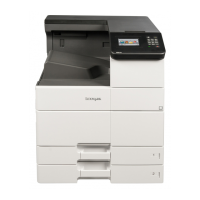Source Printing Side with the
letterhead
Paper orientation
Multipurpose feeder One‑sided Facedown Load the sheet with the
top edge on the left side.
Two‑sided Faceup Load the sheet with the
top edge on the right side.
Tips on using transparencies
• From the printer control panel, set the paper size, type, texture, and weight in the Paper menu to match the
transparencies loaded in the tray.
• Print a test page on the transparencies being considered for use before buying large quantities.
• Use transparencies designed specifically for laser printers.
• Avoid getting fingerprints on the transparencies to prevent print quality problems.
• Before loading transparencies, flex and fan the sheets to prevent them from sticking together.
• When printing on large volumes of transparencies, make sure to print by batches of only up to 20 with an interval
of at least three minutes between batches, to prevent the transparencies from sticking together in the bin. You can
also remove transparencies from the bin by batches of 20.
Paper sizes, types, and weights supported by the finishers
The printer engine supports 60–256 g/m
2
(16–68‑lb) paper weights.
Note: When a finisher is installed, the standard finisher bin becomes the default bin even for print jobs that do not
require finishing.
Supported paper sizes
Paper size Staple finisher Staple, hole punch
finisher bin 1
Staple, hole punch
finisher bin 2
Booklet finisher
A6
3 3
XX
A5
3 3 2
X
JIS B5
X
JIS B4
Executive
X
Letter
A4
1
Paper is supported only if the finisher stacks the paper but does not staple or punch holes in it.
2
Paper is supported only if the finisher stacks or staples the paper but does not punch holes in it.
3
Paper is supported but the finisher does not stack, staple, or punch holes in it.
4
Paper is supported only for 2‑hole punch.
5
Paper is supported only if the paper size is between 210 x 279.4 mm (8.27 x 11 in.) and 320 x 457.2 mm (12.6 x 18 in.).
4021, 7421
General information
31

